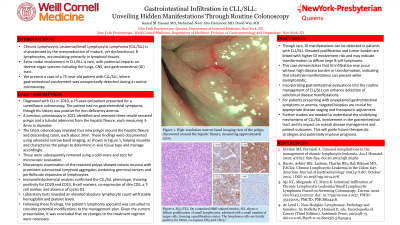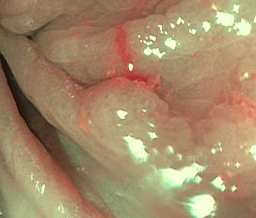Sunday Poster Session
Category: Colon
P0377 - Gastrointestinal Manifestations in Chronic Lymphocytic Leukemia/Small Lymphocytic Lymphoma: A Case of Asymptomatic Infiltration Detected During Routine Colonoscopy
Sunday, October 27, 2024
3:30 PM - 7:00 PM ET
Location: Exhibit Hall E

Has Audio

Kamal Hassan, MD
New York-Presbyterian/Queens
New York, NY
Presenting Author(s)
Kamal Hassan, MD1, Mohamad-Noor Abu-Hammour, MD2, David Wan, MD3
1New York-Presbyterian/Queens, New York, NY; 2Cleveland Clinic Fairview, Cleveland, OH; 3New York-Presbyterian / Weill Cornell Medical Center, New York, NY
Introduction: B-cell chronic lymphocytic leukemia/small lymphocytic lymphoma (CLL/SLL) is a type of cancer marked by the overproduction of mature, yet dysfunctional, B lymphocytes. These cells accumulate in lymphoid organs, bone marrow, and extranodal lymphoid tissues, causing overcrowding. Extranodal involvement can affect various organ systems, including the lungs and central nervous system, though gastrointestinal (GI) manifestations are rare. We report a case of a CLL/SLL patient with GI involvement found during a routine screening colonoscopy.
Case Description/Methods: A 75-year-old patient with a history of CLL diagnosed in 2010 underwent surveillance colonoscopy following the removal of 3 sessile serrated polyps and a tubular adenoma in the hepatic flexure measuring 3-4mm in diameter in 2021. Current colonoscopy revealed 4 polyps around the hepatic flexure and descending colon, each measuring approximately 3mm. These were removed using a cold snare technique (Figure 1). Microscopic examination of the resected polyps showed colonic mucosa with prominent submucosal lymphoid aggregates. Immunohistochemical analysis confirmed the CLL/SLL phenotype, showing positivity for CD20, a B-cell marker, co-expression of dim CD5, a T-cell marker, and absence of cyclin-D1, which is involved in the cell cycle G1/S transition. Laboratory tests revealed an elevated absolute lymphocyte count with stable hemoglobin and platelet levels. Following these findings, the patient’s lymphoma specialist was consulted to consider potential modifications to the management plan. It was concluded that no changes to the treatment regimen were necessary.
Discussion: Extranodal involvement in CLL/SLL is rarely seen in the GI tract. Elevated proliferation and tumor burden are linked with higher GI involvement risk and may indicate transformation to diffuse large B-cell lymphoma. This case demonstrates that GI infiltration may occur without high disease burden or transformation, indicating that intestinal manifestations can present while asymptomatic. Standard management for asymptomatic early-stage CLL/SLL involves careful monitoring to detect signs of disease progression and prevent complications.
In conclusion, GI evaluation with biopsies should be part of assessing treatment response in CLL patients, especially those with symptoms suggesting GI issues or unexplained anemia. This ensures early detection and management of GI involvement, potentially enhancing treatment strategies and outcomes.

Disclosures:
Kamal Hassan, MD1, Mohamad-Noor Abu-Hammour, MD2, David Wan, MD3. P0377 - Gastrointestinal Manifestations in Chronic Lymphocytic Leukemia/Small Lymphocytic Lymphoma: A Case of Asymptomatic Infiltration Detected During Routine Colonoscopy, ACG 2024 Annual Scientific Meeting Abstracts. Philadelphia, PA: American College of Gastroenterology.
1New York-Presbyterian/Queens, New York, NY; 2Cleveland Clinic Fairview, Cleveland, OH; 3New York-Presbyterian / Weill Cornell Medical Center, New York, NY
Introduction: B-cell chronic lymphocytic leukemia/small lymphocytic lymphoma (CLL/SLL) is a type of cancer marked by the overproduction of mature, yet dysfunctional, B lymphocytes. These cells accumulate in lymphoid organs, bone marrow, and extranodal lymphoid tissues, causing overcrowding. Extranodal involvement can affect various organ systems, including the lungs and central nervous system, though gastrointestinal (GI) manifestations are rare. We report a case of a CLL/SLL patient with GI involvement found during a routine screening colonoscopy.
Case Description/Methods: A 75-year-old patient with a history of CLL diagnosed in 2010 underwent surveillance colonoscopy following the removal of 3 sessile serrated polyps and a tubular adenoma in the hepatic flexure measuring 3-4mm in diameter in 2021. Current colonoscopy revealed 4 polyps around the hepatic flexure and descending colon, each measuring approximately 3mm. These were removed using a cold snare technique (Figure 1). Microscopic examination of the resected polyps showed colonic mucosa with prominent submucosal lymphoid aggregates. Immunohistochemical analysis confirmed the CLL/SLL phenotype, showing positivity for CD20, a B-cell marker, co-expression of dim CD5, a T-cell marker, and absence of cyclin-D1, which is involved in the cell cycle G1/S transition. Laboratory tests revealed an elevated absolute lymphocyte count with stable hemoglobin and platelet levels. Following these findings, the patient’s lymphoma specialist was consulted to consider potential modifications to the management plan. It was concluded that no changes to the treatment regimen were necessary.
Discussion: Extranodal involvement in CLL/SLL is rarely seen in the GI tract. Elevated proliferation and tumor burden are linked with higher GI involvement risk and may indicate transformation to diffuse large B-cell lymphoma. This case demonstrates that GI infiltration may occur without high disease burden or transformation, indicating that intestinal manifestations can present while asymptomatic. Standard management for asymptomatic early-stage CLL/SLL involves careful monitoring to detect signs of disease progression and prevent complications.
In conclusion, GI evaluation with biopsies should be part of assessing treatment response in CLL patients, especially those with symptoms suggesting GI issues or unexplained anemia. This ensures early detection and management of GI involvement, potentially enhancing treatment strategies and outcomes.

Figure: Figure 1: Polyp seen under narrow-band imaging
Disclosures:
Kamal Hassan indicated no relevant financial relationships.
Mohamad-Noor Abu-Hammour indicated no relevant financial relationships.
David Wan indicated no relevant financial relationships.
Kamal Hassan, MD1, Mohamad-Noor Abu-Hammour, MD2, David Wan, MD3. P0377 - Gastrointestinal Manifestations in Chronic Lymphocytic Leukemia/Small Lymphocytic Lymphoma: A Case of Asymptomatic Infiltration Detected During Routine Colonoscopy, ACG 2024 Annual Scientific Meeting Abstracts. Philadelphia, PA: American College of Gastroenterology.
